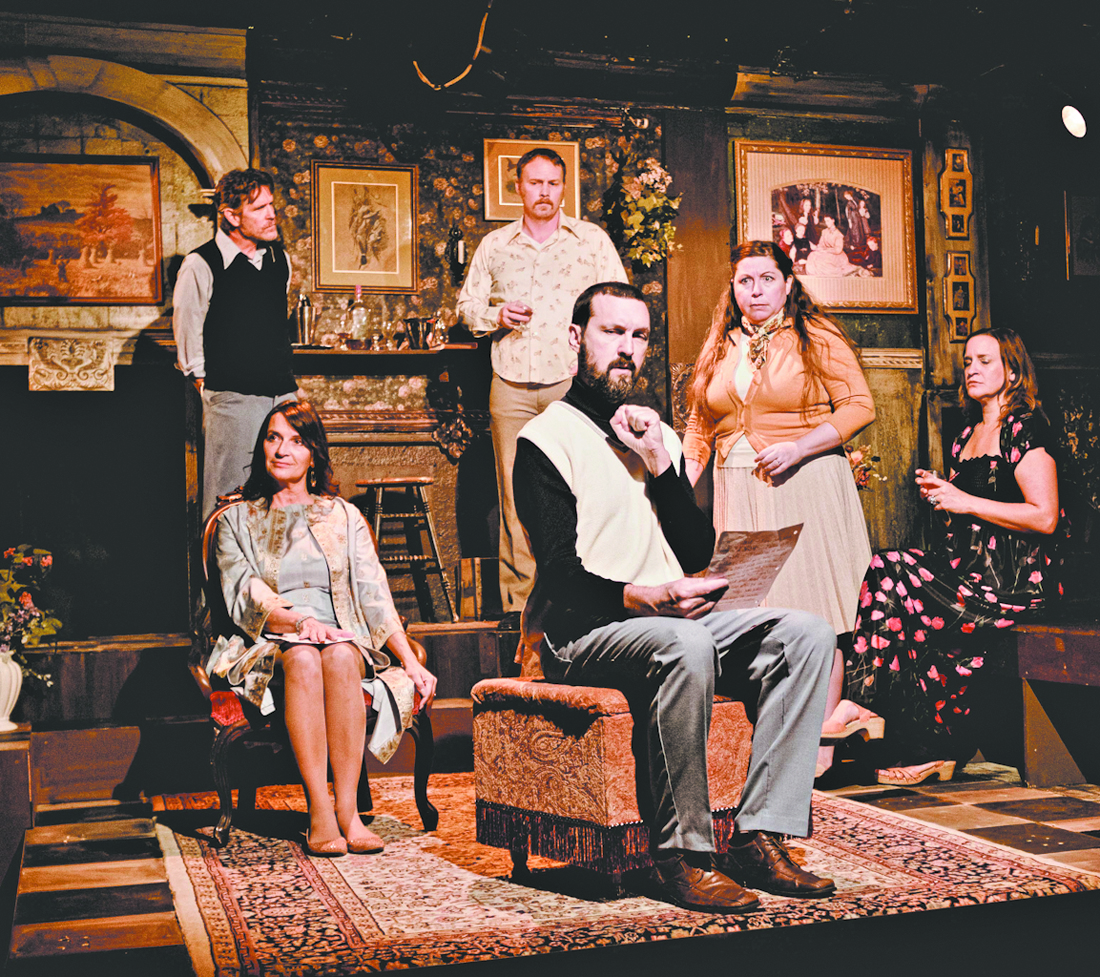Terror inside
A richly designed, well-acted adaptation of classic ghost story

In the house with (clockwise from center) Brett Edwards, Leesa Palmer, Rob Wilson, Steve Swim, Amber Miller and Samantha Shaner.
Photo by Joe Hilsee
The stage at the Blue Room Theatre is immaculately set in the mode of a Victorian-era mansion. Sepia tones are dramatically accented by the deep scarlet of a diamond-tuck velvet upholstery on an elegant armchair near the front of the stage. Eerie but enchanting music floats through the room. Every horizontal surface is bedecked with bric-a-brac and curios and figurines and books and decanters of intoxicating fluids, and every vertical surface supports a painting. Beneath a marble arch, ghostly flames ascend the chimney of a grand fireplace.
Amber Miller’s gorgeously realized set is impressive in its detailed execution. And it’s the perfect setting for the theater’s current production of Shirley Jackson’s classic 1959 ghost story, The Haunting of Hill House, directed by Joe Hilsee, who co-adapted the story with assistant director Miller.
Obviously a labor of love for Miller, who according to Hilsee’s director’s notes has been visualizing a local adaptation for “about 10 years,” the current production also draws on “one of her favorite movies,” the 1963 cinematic version of the book, The Haunting, starring Julie Harris, for inspiration. And, this being a Blue Room original, in the spirit of post-modern absurdity that the theater has embraced and embodied since its inception, there are elements of humor and references to current pop-culture that elevate both the eerieness and goofiness of the source material.
In updating the story, Miller and Hilsee have created an anachronistic framing device that has Carrie Sanderson (played by Stephanie Ditty), in the present day, on the verge of opening the allegedly haunted mansion to paranormal researcher Dr. Monatague (Rob Wilson), so he and his team can conduct experiments to determine if the haunting is “real.” To convince her of the validity of his quest, he gives Carrie a diary written by former inhabitant of the house Eleanor Vance (Miller), whose ghostly presence allegedly still haunts the residence.
Assisting in the negotiations is “the Lawyer” (Hilsee). Complicating the chronological challenges of the narrative is the entrance of Theodora (Samantha Shaner), a glamorous dipsomaniac who is (apparently) along to assist with the research, but whose main interest and purpose is to supply a giddy sense of aloof but pointed humor to the proceedings. Enabling her enthusiasm for intoxicants is Luke Sanderson (Steve Swim), a man always ready to fetch a crate of alcohol and mix drinks for all, including the doctor’s elegant wife, Mrs. Montague (Leesa Palmer) and her attendant/gigolo, Arthur (Brett Edwards).
Miller has given each character moments to shine, and the impressive cast of some of Chico’s finest players makes each vignette within the play sparkle with humor and a glimmer of supernatural horror. Thus, house mistress Mrs. Dudley’s (Mary McCluskey) admonitions to never leave the house after dark is both a running joke and a foreshadowing of spooky doings.
When Carrie retires to a comfy reading chair upstage to read the diary that Dr. Montague has given her, the action of the play regarding Eleanor’s breakdown and possible entrance into the afterlife is drawn onto the main stage and played out as a projection of her imagination. This deliberate layering of multiple timeframes and points of view made me appreciate the dramaturgy alongside the artistry of the players. However, it also made me feel like I’d viewed all the exquisitely crafted pieces of a puzzle that never quite all fit together, but nonetheless could be appreciated as a kind of lovely shattered tableau.





